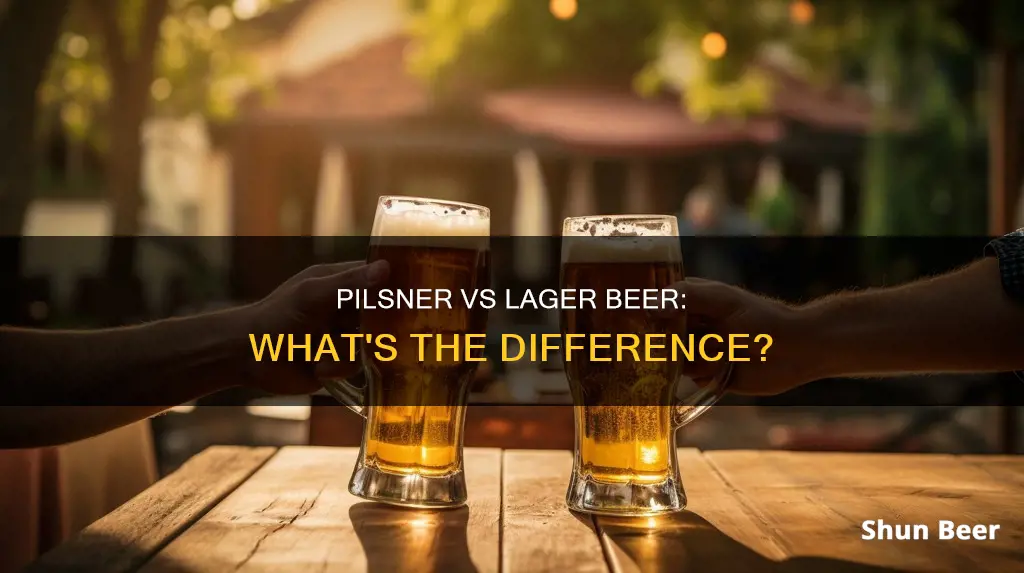
Pilsner and lager are both types of beer, but there are some key differences between the two. In simple terms, a pilsner is a type of lager. All pilsners are lagers, but not all lagers are pilsners. Lager is a type of beer conditioned at low temperatures and can be yellow, pale, amber, or dark in colour. Pilsner is a pale lager and is the most widely consumed and commercially available style of beer. It tends to be light to gold in colour and has a strong hoppy flavour.
What You'll Learn

Pilsner is a type of lager
Pilsner is indeed a type of lager. In fact, the world's most famous pilsner, Carlsberg Pilsner, is a full-bodied, refreshing, and characterful international premium pilsner.
Lager is a type of beer conditioned at low temperatures. It can be yellow pale, amber, or dark. Pilsner is a pale lager and is the most widely consumed and commercially available style of beer.
Lager is a collective name for many bottom-fermenting beer styles, ranging from dark and rich to light and crisp, with alcohol percentages ranging from zero to double digits. Pilsner is a type of lager named after the Czech city of Plzen.
The most notable difference between lager and pilsner is that pilsners tend to have more hop-forward flavours and they use different yeasts. Ultimately, pilsners are just spicier, more hoppy lagers.
Pilsner was first brewed in 1842 by the Bavarian brewer Josef Groll, who wanted to produce a good-quality lager. Groll brought a special yeast from Bavaria, which, when mixed with the soft water of Plzen, produced a clear, crisp, golden beer.
Stout vs Porter: Unveiling Beer's Dark Secrets
You may want to see also

Lagers are light in colour, high in carbonation, and made from bottom-fermenting yeast
Lagers are a type of beer conditioned at low temperatures. They can be yellow-pale, amber, or dark in colour. Pilsner is a type of lager, and the most widely consumed and commercially available style of beer.
Lagers are light in colour, ranging from pale yellow to amber. They are also high in carbonation and made from bottom-fermenting yeast. Bottom-fermenting yeast works at the bottom of the wort at a much lower temperature than top-fermenting yeast. This yeast tends to settle at the bottom of the fermentation vessel during the brewing process. The temperature range for lager fermentation is typically between 44–55 °F (7–13 °C).
The low-temperature fermentation and maturation of lagers result in a beer with a cleaner flavour profile than its top-fermented counterpart. The extended cold storage, or "lagering", also makes these beers more shelf-stable than ales, which explains why most of the world's beers are of the lager variety.
Lagers are often associated with a crisp, clean, and smooth taste. The bottom-fermenting yeast imparts distinct characteristics to lagers, contributing to their crisp and clean taste and allowing for an extended maturation period at cooler temperatures.
Explore the Difference Between Ales and Lagers in Beer
You may want to see also

Pilsner is a pale lager with a strong hoppy kick
Pilsner is a type of lager beer. All pilsners are lagers, but not all lagers are pilsners. Lager is a type of beer conditioned at low temperatures and can be yellow pale, amber, or dark in colour. Pilsner is a pale lager, and is the most widely consumed and commercially available style of beer.
Pilsner gets its name from the city of Pilsen in Bohemia (modern-day Czech Republic). It was first brewed in 1842 by Bavarian brewer Josef Groll, who aimed to produce a good-quality lager. Groll used a special yeast that, when mixed with the soft water of Pilsen, produced a clear, crisp, golden beer.
Pilsner is a fairly dry, spicy, and hoppy lager. It is traditionally produced with pilsner malt, which generally comes from two-row barley, and contains more hops than a standard lager. Pilsners are light to gold in colour, and the taste gives a strong hoppy kick. They are best served in a tall, tapered glass with a wide mouth, smaller than a pint glass.
Pilsners are just spicier, more hoppy lagers. They are produced with different yeasts, which ultimately give them a more hop-forward flavour. They also tend to be more bitter than other lagers.
Beer vs Lager: What's the Difference?
You may want to see also

Lagers can be yellow pale, amber, or dark
Lagers come in a variety of colours, from pale to dark. The colour of a lager depends on the grain bill used in the beer.
Lagers can be pale, which is the most common and widely consumed style of beer. Pale lagers are usually mild in flavour and are often served chilled. Pilsners are a type of pale lager, and are the most widely consumed and commercially available style of beer.
Lagers can also be amber in colour. Amber lagers are generally darker than pale lagers and often have a deep tan or amber colour. Some common styles of amber lager include Märzen, Vienna lager, and Oktoberfest beers.
Lagers can also be dark, such as Dunkel and Schwarzbier. These lagers have a more roasted, slightly burnt flavour profile due to the use of roasted grains and malts.

Pilsner has a longer expiry date and is heavier on hops
Pilsner and lager are both types of beer, but there are some key differences between the two. Firstly, it's important to understand that while all pilsners are lagers, not all lagers are pilsners. So what sets pilsners apart from other lagers? Well, one notable difference is that pilsners tend to have a longer expiry date. This is thanks to the use of hops, which act as a preservative and give pilsners a longer shelf life than other types of lager.
Indeed, hops play a significant role in defining the character of pilsners. Pilsners are known for being heavier on hops, with more hop-forward flavours than other lagers. Hops are used in the brewing process for all types of beer, but pilsners contain more hops than standard lagers. This is because hops act not only as a preservative but also as a flavouring agent, giving pilsners their distinctive spicy, hoppy kick.
The story of how pilsner came to be is closely tied to the use of hops. In the early 1800s, brewers in the city of Pilsen in Bohemia (now the Czech Republic) made a batch of lager that spoiled. They called on Bavarian brewer Josef Groll for help, and he made the decision to increase the quantity of hops in the beer. Thus, in 1842, the first pilsner-style lager was born at the Pilsner Urquell Brewery.
Pilsner is a type of pale lager, and it is the most widely consumed and commercially available style of beer. Pilsners are traditionally produced with pilsner malt, which comes from two-row barley. They are light to gold in colour, and their flavour profile is characterised by strong, spicy, and hoppy notes.
In summary, pilsner is a unique type of lager that stands out for its generous use of hops, which not only extend its expiry date but also give it a bold, spicy, and hoppy flavour. So, if you're a beer lover who appreciates the preservative and flavouring powers of hops, pilsner might just be the perfect choice for you!
Frequently asked questions
A pilsner is a lager, but not all lagers are pilsners. Lager is a type of beer conditioned at low temperatures. Lagers can be yellow pale, amber, or dark. Pilsner is a pale lager and is the most widely consumed and commercially available style of beer.
Lager is one of the two main types of beer, the other being ale. The only difference between the two is the type of yeast used. Lager uses fermenting yeast at the bottom of the container, which causes it to feed itself slowly with sugars, providing a crisp flavor.
Pilsner is a type of pale lager that is light to gold in color and has a strong hoppy flavor. It is best served in a tall, tapered glass with a wide mouth, smaller than a pint glass.







